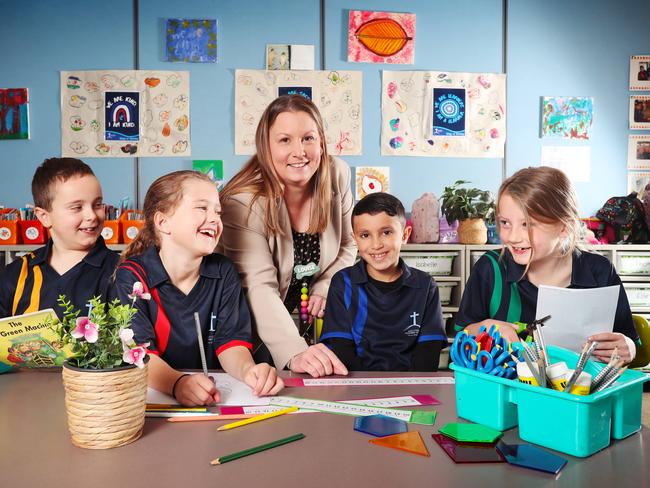Victorian regional schools in crisis as teacher vacancies double city rates
Victoria’s regional towns are running out of teachers at an exponential rate — but one school in the Macedon Ranges has defied all odds at keeping educators in the classroom.
Education
Don't miss out on the headlines from Education. Followed categories will be added to My News.
Victoria’s regional areas are running out of teachers, with job vacancy rates twice as high in some country areas than the city, state data shows.
After dipping to less than 1000 in recent months, in Victoria this week there are 1743 unfilled jobs, including 1032 teachers, 671 teaching assistants, 33 assistant principals and seven principals.
By 2028, there will be a shortfall of 6737 teachers in both primary and secondary state schools across the state.
The jobs include 1220 in metropolitan areas and 523 in the regions, with country areas containing 20 per cent of the population but 30 per cent of the vacancies.
Experts say longer hours and increased workloads are driving teachers in regional Australia to want to quit the profession before retirement age as all states grapple with dire vacancies and supply forecasts.
The need for a National Teacher Workforce Action Plan was agreed to by all education ministers in December 2022.

But it can be revealed a national geographical snapshot identifying the regions and specialities with the worst shortages won’t be publicly available until next year.
In Victoria, areas hardest hit include the Geelong region with 60 vacancies as of this week, 56 in Whittlesea on the northeast outskirts of Melbourne, 39 in the Shepparton region, 36 in East Gippsland and 30 in the Latrobe Valley, also in Gippsland.
Compounding the problems, applications per vacancy are up to six times lower in country areas, with some schools getting no applications at all for jobs at all.
In the last two years, vacancies in some areas such as Goulburn near Shepparton were up 86 per cent – the highest in the state.
Meanwhile, there were 67 teaching and school leadership vacancies across Catholic schools in Victoria, including eight in Warragul, five in Wangaratta and five in Sunbury.
Despite thousands of registered teachers living in the country areas of Victoria, there are more than 5000 who are choosing not to work in schools, according to the latest Supply and Demand report.
The Australian Institute for Teaching and School Leadership (AITSL) acting CEO Edmund Misson said the teacher workforce shortage had become more pronounced since Covid.
“For the 10 years leading up to Covid, the picture was that there were shortages, but they’d be either in rural areas or lower socio-economic areas of cities,” he said.
“Even though there’s no national published data on this yet … clearly anyone who’s trying to run a school or a school system is saying that there is a shortage … and I think it’s clear that it’s worse in regional areas.”

A recent AITSL report found “workload and coping” remained the top reasons for teachers leaving regional and remote teacher jobs, increasing from 88 per cent in 2020, to 92 per cent in 2021 and 2022.
It found that from 2020 to 2022, the proportion of the teacher workforce in regional and remote areas intending to stay in the profession until retirement decreased by 13 percentage points from 41 per cent to 28 per cent.
It was also found the teacher workforce in the most remote areas were around 10 per cent more likely to work 50 plus hours per week, compared to their counterparts in major cities.
The issue of teacher shortages is caused in part by a higher attrition rate in country schools.
The attrition rate in secondary schools has hit ten per cent in Outer Gippsland – nearly twice as high as the lowest metro area.
The problems remain despite lucrative financial schemes to lure teachers to take jobs at hard-to-fill schools.
The Herald Sun revealed in April that the Department of Education launched a jobs campaign to recruit teachers at Greater Shepparton Secondary College (GSSC), with educators being offered a $50,000 sign-on bonus for a two-year commitment and an additional $10,000 a year at the conclusion of the second, third and fourth year of their employment.
State opposition education spokeswoman Jess Wilson said: “No student can achieve their best learning in a doubled-up classroom or by being sent home at lunch because Labor cannot manage our teaching workforce”.

“Despite claiming to have spent more than $1.6bn since 2019 on workforce initiatives – the situation is getting worse and students’ educational outcomes continue to fall,” she said.
A state government spokeswoman said: “Student teachers deserve support to pursue their career without financial pressure – which is why we’re supporting student teachers to undertake their placements in regional, rural and specialist schools.”
“We’ve made Victoria the best place in Australia to study teaching – investing $1.6 billion since 2019 on teacher attraction and retention, including free teaching degrees, scholarships and a program to support new graduates,” she said.
The regional school defying all odds
As Victoria’s regions grapple with teacher shortages, one school in the state’s northwest has come up with a rewarding solution that’s kept educators in classrooms.
Located in the foothills of the Macedon Ranges, Holy Cross Primary School New Gisborne’s aspiration to be the “employer of choice” has paid off with the school home to 34 staff, including 26 teachers.

Principal Aoife McCarthy said her approach to recruiting staff has led to five new teachers joining the school in the past two years, with those new staff members still at the school today.
“When I’m advertising roles, I not only outline what we want (from a candidate) but I also share what we can offer the teacher as well,” she said.
“For example, we have retained teaching staff by offering mentors and professional development that aligns with their needs and the goals of our school.”
There are 229 students from prep to grade six currently enrolled at the Melbourne Archdiocese Catholic school, which sits on 22 acres of land and is also home to chickens, sheep, an olive grove, veggie garden and fully operational vineyard.

Ms McCarthy said it’s facilities such as these – which aren’t typically offered at metropolitan schools – that teachers can experience if they make the move to a regional school.
“(Working in the regions) is a chance to be part of a community, to form relationships with families and really feel a connection,” she said.
While Holy Cross Primary School has overcome teacher shortages, Ms McCarthy empathised with principals doing it tough.
“Everyone should know and understand that principals are working hard because they want to see their students flourish,” she said.
“One way to do that is by having access to quality teaching staff who are empowered in their role.”



